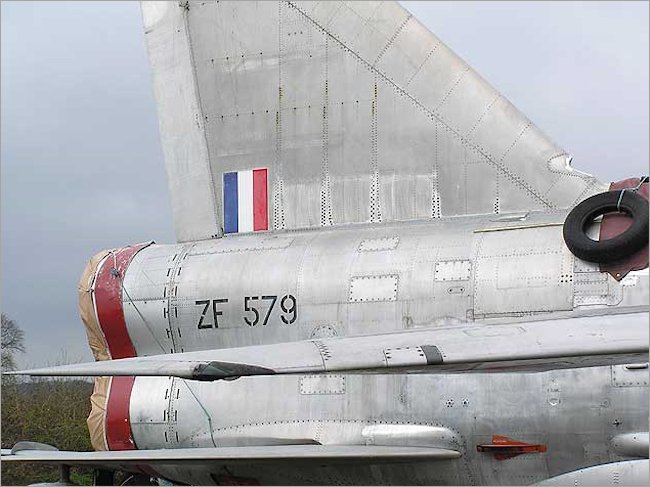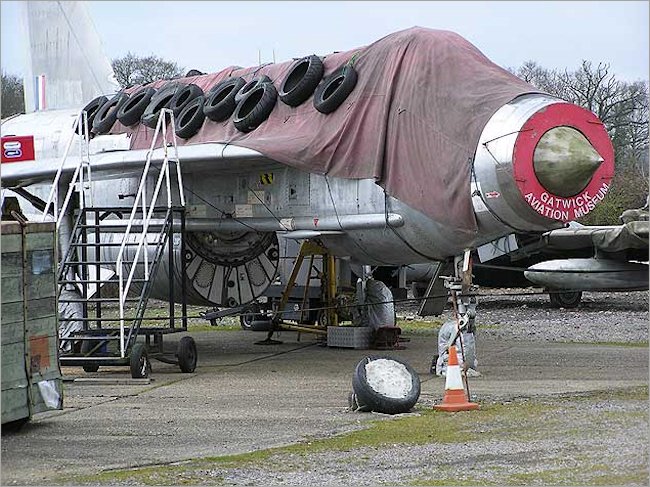English Electric Lightning
The Gatwick English Electric Lightning ZF579 is an F.53, export version Serial 53-671, exported in 1968 to RSAF Jeddah as no 203 with 2SQ. At the end of her career in Saudi, she was ferried back to British Aerospace Warton in January 1986. ZF579 was retired, dismantled, and moved to Portsmouth for deep storage, languishing in a water sodden container for 7 years. ZF579 is one of the few ex Saudi examples to be in sound overall condition. Most suffered very badly during their storage in wet containers. In 2000, the aircraft was a shell, 579 looked in a very sorry state.
After inspection, it was decided feasible to completely re-build ZF579, with an overall schedule of 8-9 years to fully restore as close to original condition as possible, as a preserved and only "live" F53 machine in the world. The program started in August 2001. The end goal is a fully functioning aircraft. Returning the airframe to a fully live condition will ensure its protection and future

Photograph taken at the Gatwick Aircraft Museum next to Gatwick Airport Sussex England
The late Brian Carroll, a former RAF Lightning pilot and ex-Lightning Chief Examiner, reported taking a Lightning F.53 up to 87,300 feet (26,600 m) over Saudi Arabia at which level "Earth curvature was visible and the sky was quite dark" but control-wise it was "on a knife edge". In 1984, during a major NATO exercise, Flt Lt Mike Hale intercepted an American U-2 at a height which they had previously considered safe from interception. Records show that Hale climbed to 88,000 ft (26,800 m) in his Lightning F.3 XR749.
I still remember seeing one of the last English Electric Lightning performances at an airshow when I was a little boy. It was like seeing a ballistic rocket launch up into space. The afterburner noise, speed and sheer power were amazing as it pointed its nose up to the heavens and kept going. It was what this aircraft was designed for and did so well. Any Soviet bomber heading towards UK airspace during the Cold War would activate an RAF English Electric Lightning scramble. The RAF pilots would be strapped in their seats on top of a sky rocket sent off to kill the invaders; that was the Lightning. With a service ceiling of 54,000 ft (16,000m) to just under 70,000 ft no high altitude bomber of that time could escape. It was also used as a fighter and ground attack aircraft but its limited range was a drawback.

Photograph taken at the Gatwick Aircraft Museum next to Gatwick Airport Sussex England
It had a maximum speed of Mach 2.0 (1,300 mph, 2,100 km/h) at 36,000 ft. 700 KIAS at lower altitude and a range of 850 miles (1,370 km). In high altitude interceptor mode the range decreased to 155 miles (250km). For armament it had two 30 mm (1.18 in) ADEN cannons and two under-fuselage hardpoint mountings for air-to-air missiles, and two overwing pylon stations for 260 gal ferry tanks. It would carry either two Havilland Firestreak air to air missiles or hawker Siddeley Red Top missiles.
Luckily the Cold War did not turn into WW3. The English Electric Lightning was never used in a war situation. It was replaced in the ground attack role by SEPECAT Jaguars and in the interceptor role by Tornado F3s. Although slower and less agile than the Lightning, the Tornado carries a much larger armament load and much more advanced avionics and weapons.
For News and information on visiting the Gatwick Aviation Museum go to their website at www.gatwick-aviation-museum.co.uk